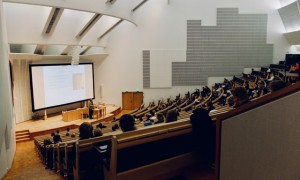
生命科学研究,生命科学研究中常用建模方法表示微观物质
*文末附有全文的英文版本
English version id at the end of the text
生命科学的研究领域及当下发展
生命科学,正如其名字所示,是一门研究各种形式的生命体的科学。生命科学属于生物学领域,其研究的范围包括植物、动物、病毒和细菌、单细胞生物,以及细胞。生命科学主要研究不同生命体在不同时期的生存形态、生命现象、生命活动的本质、特征和发生、发展规律,以及各种生物之间和生物与环境之间相互关系 (李志民,2018) [1] 。
从其研究领域上看,生命科学似乎是一门高深莫测、离我们日常生活很远的学科。但从生命科学研究的影响和目的的角度看,其研究“用于有效地控制生命活动,能动地改造生物界,造福人类。生命科学与人类生存、人民健康、经济建设和社会发展有着密切关系” (李志民,2018) [2] 。作为当今在全球范围内最受关注的基础自然科学,生命科学的研究与人类社会的生存和发展息息相关。
在人工智能、计算机、大数据等技术飞快演进的大背景下,生命科学的研究工具越来越丰富,研究的问题也越来越多样化。2021年11月举办的世界顶尖科学家论坛聚焦于讨论生命科学研究的新风向,以“开放科学:构建开放创新生态”为主题。在该论坛中,2013年诺贝尔化学奖得主,世界顶尖科学家协会副主席迈克尔·莱维特就当下生命科学的发展谈到:“生命科学几乎在每个重要领域都在影响我们,如在气候控制、可持续能源、食品安全等所有方面。生物学能为我们带来社会经验,它告诉我们,那些伟大的幸存者必须是融合的,必须是多样化的。所以一个强大的社会,一定是一个高度多样化的社会,那些基因上纯正的社会并不会成功”(第一财经,2021)[3]。
由此可见,生命科学向多学科领域“破圈”。无论你是否立志成为科学家,对生命科学不同程度的探索都可以作为你了解世界的方式。因此,各领域的学者都应当对生命科学研究的发展投以密切的关注,以加深对人类社会生存和发展趋势的理解,从而更高效地开展各学科的前沿研究。
为了开展科学研究,生命科学的研究机构往往有自己的实验室或者合作的实验室,来进行环境分析、微生物分析、环境取证分析等研究,满足生命科学研究中的实验室测试和检验的需求。在下文中,我们将依据2021年QS生命科学领域的排行榜,走进世界知名大学所拥有或合作的全球首屈一指的生命科学实验室,通过对其发展及所做的研究进行全面且深入的分析,总结讨论顶尖的生命科学实验室的共性以及目前可见的生命科学实验室的发展趋势。希望读者通过阅读此报告,可以在一定程度上理解生命科学的前沿研究领域,全面了解全球顶尖的生命科学实验室,并领会生命科学研究与日常生活以及人类社会发展的关系。
哈佛大学-鲍尔生命科学实验室
哈佛大学内藤化学楼和鲍尔生命科学楼综合体(Harvard University Naito Chemistry and Bauer Laboratory Complex)的建筑本身便是生命科学研究精神的体现。哈佛大学大气化学教授 Philip S. Weld说,“该建筑综合体巧妙地融合了实验的复杂性、精湛的建筑设计和公共空间的创新使用。它们代表了 Ellenzweig(波士顿建筑设计师)和该系多年来就发展最先进的实验室和研究基础设施以用于强大的新研究领域进行密切交流的体现”(Ellenzweig)[3] 。
图片来源:ellenzweig官网
据哈佛官网所示 [4] ,鲍尔的核心实验室的研究目标是以多领域合作的方式推进生命科学领域的研究工作。不同于传统的学术实验室,鲍尔核心实验室不仅提供该学科领域最先进的仪器(如DNA 测序仪,多模成像仪,流式细胞仪等)和专业知识(分析协议、方案、服务等),还将其大规模的实验室和计算资源向哈佛各个领域的科学家和学者开放。
在促进科学领域合作上,一方面,鲍尔核心实验室建立了针对不同分支领域研究的网上论坛 [5] ,实验室的技术人员与不同科学领域的科学家在论坛中就实验设计、技术选择等方面进行实时讨论和合作。另一方面,鲍尔核心实验室的技术团队在实验的多个方面提供咨询并予以支持,如协助研究人员的特定实验目标调整其实验设计及进行实验仪器培训,培训和支持研究人员的样本分析并提供研究工具以实现更多的实验分析等。鲍尔核心实验室的这些研究合作方式更大程度地以不同科学领域之间合作的形式促进前沿科学研究的发展。
鲍尔核心实验室对研究人员的要求也十分严苛,有机会进入该实验室进行研究的学者不仅需要拥有熟练使用前沿仪器的技术,也需要把握如流式细胞、光体分析等相关领域的最新发展和趋势。据鲍尔核心实验室官网的研究人员培训政策所示 [6] ,研究人员需要接受培训才可以独自运行FACSAria仪器进行细胞分选等研究。培训包括每隔一周的“流式细胞术简介”研讨会以及实验培训课程。对于需要运行一些特殊仪器进行样本分析的研究员,鲍尔核心实验室要求其进行更多的额外培训:如需要对其样本运行96或384孔板的研究员,需要进行额外的细胞分析仪培训;需要使用Aurora 光谱分析仪的研究员需要参加额外的研讨会和实践培训课程。研究人员在接受培训后还需要通过启动仪器、执行分类和关闭仪器的考核,证明其熟练程度后,才能独自使用仪器。而对于六个月未使用仪器的研究员,实验室要求他们重新进行上述系列的培训以重新获得仪器使用权。
据哈佛大学文理学院官网所示 [7] ,截至目前,在鲍尔核心实验室及其科学研究计算组部门的支持下,哈佛大学文理学院已出版27篇文章。据列表显示,其研究内容均为对于当下大环境的最新研究或特定领域的前沿研究,如流感抗体的演变(An Adaptation of Sorted Neighborhood Methods for Deduplicating Pedigree Data),新型甘露糖异构酶(Kinetic study and molecular dynamics simulation of two novel mannose isomerases)等。官网显示,2009年至2021年期间,该学院在实验室的技术支持下持续输出前沿的科学研究,其中2018年发表高达74篇研究文章。实验室的技术与人员支持在这些持续不断的前沿研究中发挥着不可或缺的作用,同时,这些先进的研究也促进实验室持续地维持其先进性,并为了这些实验目的不断地更新生命科学的专业知识以及设备。
由此总结,哈佛大学鲍尔生命科学实验室凭借其先进的专业设备和专业人才,通过推进不同科学领域的合作研究,在全球的生命科学领域保持着其先进的地位。
加州大学旧金山分校合作实验室-Autobahn Labs
Autobahn Labs是一所与领先的生命科学投资公司 Samsara BioCapital,全球药物发现研发和发展合作公司Evotec SE,和KCK Ltd家族投资基金合作的实验室。该实验室立志于加速新科学的发展,为患者提供变革性的新疗法。通过投资智力、财力和物质资本,应用经过验证的药物研发框架,有效地将项目从可行性研究推动到新的候选药物研发 [8] 。不同于专注于研究的传统实验室模式,这种实验室的新模式推动融合多个科学领域的专业知识,全球药物研发技术和能力以及金融资本,将其应用于最有前途、最前沿的科学研究,并将其研究成果推广于医学实践。
知识资本
研发操作的专业知识
一支拥有多科学领域、药物研发和运营专业知识的专门团队。
金融资本
投资者愿景
对生命科学领域进行深度投资,将项目推进到临床前候选药物以及更多领域。
物质资本
药物研发
用工业化药物研发能力,推动新药研制的发展。
在加州大学旧金山分校创新投资办公室的支持和探索下,该校与 Autobahn Labs正式建立了战略合作,希望通过此项合作将在医疗领域上有应用前景的科学发现更快地推向市场。Autobahn lab和加州大学旧金山分校之间的合作建立在 Evotec SE的“BRIDGE”模型—— Biomedical Research, Innovation & Development Generation Efficiency(生物医学研究、创新和开发效率)的基础上,该模型将早期学术研究转化为药物研制和发展。
加州大学旧金山分校以健康科学领域的研究见长,在生命科学相关的学科领域颇有建树。该校产出大量具有开创性的科学发现,如该校生理学系教授兼主任大卫·朱利叶斯 (David Julius) 在其长达数十年的职业生涯中专注于研究人体如何感知热、冷和化学刺激物,对疼痛的基本性质和疼痛治疗的新目标有了新的认识。因其在神经疼痛科学领域的突破性创新研究,获得2021年诺贝尔生理学或医学奖;该校的健康医生通过利用与抑郁大脑模式相关的特定大脑回路,并使用类大脑起搏器的方式进行重置,成功地治疗了一名患有严重抑郁症的患者。该项研究发表在2021 年 10 月 4 日的《自然医学》杂志上,象征了科学家多年来将神经科学学术领域上的进步应用于精神疾病治疗的努力取得的里程碑式的成功 [9] 。
由此可见,加州大学旧金山分校在生命科学领域上的研究与Autobahn Labs的发展目标有异曲同工之处,即立志于通过先进的生物医学研究,不断丰富生命科学和健康专业领域的学术知识和研究,从而推进全球的病人医疗护理、药物治疗等临床医学更加卓越,在世界范围保护人类身体和精神两方面的健康状况。
由于双方的共同发展方式和目标,加州大学旧金山分校与Autobahn Labs都非常看好此项合作的发展潜力和对于生命科学领域的积极影响。对此,加州大学旧金山分校的业务发展、创新和合作伙伴关系副校长巴里塞利克博士说:“创新投资办公室的目标是帮助加州大学旧金山分校的教职工和学生将他们的创新从实验室转移到市场,在那里他们可以发挥最大的作用,与 Autobahn Labs 合作将使我们能够将我们广泛的科学专业知识与他们在药物开发方面的经验联系起来,以快速获得最佳疗法,从而使患者受益”[10] 。同时,Autobahn Labs 的首席科学官 Thomas Novak 博士表示:“加州大学旧金山分校兼备了世界一流的医学知识、前沿的研究和药物创新研发的辉煌记录。我们很高兴与 UCSF 合作一同合作,促进为患者寻找和开发有价值的新疗法” [10] 。
基于催化创新科学转化为变革性新疗法的愿景 [11] ,Autobahn Labs以一种科学的方式持续着其自身的发展 — 从提出问题,研究解决问题,到将解决方式投入到市场进行实际应用。Autobahn Labs通过与具有广泛科学专业知识的研究员和机构合作,不断提高实验室的知识资本,并在通过与投资公司合作,保证其设备和财力的基础上,持续推进可应用临床药物的研发,以推进新产品的研发和医药市场发展的方式,实质性地推动毒理学、病理学以及整个生命科学领域的发展。
伦敦大学学院-High-Content Biology Laboratory
伦敦大学学院拥有伦敦排名第一、全球排名第十(2021 年 QS 世界大学排名)[12]的生命科学专业。该学院在生命科学和生物学的专业服务团队的支持下,优秀的学生、研究员和学者致力于生命科学领域的研究、教学和持续不断地学习。
伦敦大学学院拥有自己致力于生命科学研究的基础设施,其中便包括高含量生物实验室(High-Content Biology Laboratory)。该校生命科学学院以创新和协作闻名,其学生和研究员不断推动生物学、遗传学和神经科学等领域的新思想发展,以解决世界上一些最紧迫的问题。
从 COVID-19 到气候变化的研究,伦敦大学学院生命科学学院的研究人员持续在生命科学学科的不同领域取得重要的学术研究进展,包括神经科学、遗传学、结构、分子、细胞、环境生物学、生物多样性和药物等。在该学院官网中展示的一系列成就中,最突出的一项为2014年的诺贝尔奖成就 [13] 。约翰·奥基夫教授(John O’Keefe)通过研究大鼠大脑中的海马体,在实验室观察单个脑细胞的活动,发现当大鼠处于环境中的特定物理位置时,每个位置细胞(place cell)都会做出反应。这些细胞共同构成了每个环境的认知地图。这一发现通过约翰·奥基夫教授对认知地图神经基础的进一步研究,揭示了更多的位置细胞。因为这一开创性的发现,约翰·奥基夫教授获得了2014 年诺贝尔生理学或医学奖。
High-Content Biology Laboratory为伦敦大学学院在生命科学领域的创新研究提供着不可或缺的力量。据该学院官网显示 [14] ,该实验室拥有先进的仪器,通过使用高通量筛选技术促进转化研究(translational research)的推进,并重点使用和发展高含量筛选技术(high-content screening)。与此同时,该实验室的仪器充分允许研究员进行其他分析系统,如共聚焦显微镜、荧光、吸光度、发光、流式细胞术等领域的研究。
基于领先的硬件条件,该实验室持续聚焦研究前沿生命科学主题。在全球疫情流行的背景下,该学院开展了涉及人类免疫缺陷病毒或肝炎病毒等生物安全3级病原体的项目 [14] 。实验室为该项目研究的开展提供了高通量筛选平台,并且为该平台的生物安全柜设置了独特的液体处理机器人(CyBio WellVario, CyBi Drop),能够以384井的格式全自动处理传染性样品,充分保证了研究人员的安全和身体健康。
图片来源:UCL官网
与Autobahn Labs相似,High-Content Biology Laboratory同样立志于将其具有创新性的学术研究成果投入于药物的研发。该实验室的转化细胞生物学教授罗宾凯特勒(Robin Ketteler)说 [15] ,“作为对早期药物发现感兴趣的学术生物化学家,我们总是面临着将任何化学热门物质和问题进一步研究和开发的瓶颈。TRO 药物研发小组有很强的团队合作能力,这很有助于围绕热门化合物进一步推进研究,给了我们开辟新的研究思路以及新药物的机会”。该教授的话在强调其学术研究实用性推动目标的基础上,进一步突出了该实验室的创新能力与合作能力。在该教授的带领下,他们的研究将有效推动用于识别癌症和神经退行性疾病等疾病的潜在治疗靶点策略的发展。该实验室将基础研究结果转化为药物研发计划,以促进潜在的治疗先导化合物的发现。该研究模式和目标维持推动了该实验室在全球顶尖地位的保持。
High-Content Biology Laboratory也不断与其他大学展开科学领域的合作(如牛津大学药物研发研究所ARUK DDI,剑桥大学生物学实验室MRC LMB等),为其在生命科学领域的研究开辟更多前进方向。
总而言之,伦敦大学学院的High-Content Biology Laboratory汇集了具有广泛和先进的学科知识的研究员,基于其实验室先进的设备,多个科学领域和不同学院、国家的研究员进行深度合作、讨论和碰撞,挖掘生命科学领域前沿话题的研究,并以转换药物研发为目标进行研究。
总结与讨论
全球顶尖的生命科学实验室远远不止上文中所列出的三所,并且正如这些生命科学实验室与其他领域的科学家进行合作发展,也有很多相关科学领域的实验室直接或间接地为世界生命科学领域做出贡献。通过深度了解三个全球顶尖的生命科学实验室的先进因素、发展模式及发展目标,以及通过分析各个实验室的运行和发展特点,在此可以大致总结归纳出顶尖生命科学实验室的共性。
第一,优秀人才汇集以及先进的硬件设备支持。充足的知识资本、技术资本和物质资本为实验的准确性和先进性提供了不可或缺的基础,支撑着前沿研究及其成果的持续输出。
第二,跨领域合作。正如开篇部分迈克尔·莱维特对于生命科学的发展所作的评论,先进的实验室往往拥有“破圈”的能力,即与其他相关科学领域的科学家、机构或实验室进行合作研究。不同思维方式和专业领域的碰撞有利于更高效地发现有创新性、突破性的研究方向。
第三,研究成果转化。学术研究成果不仅是理论上的成就,更能推动生命科学领域的实质性发展。如上文中提到的临床药物研发或精神疗法等,都从生命科学研究的角度为人类社会的发展做出了不可估量的贡献。
Elek Molnar教授说 [16] ,“作为生命科学家,我们的研究能力是极其特别”。从本研究报告中我们可以了解到,生命科学家所做的研究影响着人类健康及人类社会的发展,生命科学实验室也在其研究过程中发挥着至关重要的作用。希望本研究报告可以加深读者对于生命科学实验室以及生命科学领域研究的理解,并产生兴趣去更深入地了解该领域所做的前沿研究。
English Version
Research Fields and Current Developments of Life Science
Life science, as its name suggests, is a science that studies various forms of life. Life science belongs to the field of biology, and its research area includes plants, animals, viruses and bacteria, single-celled organisms, and cells. Life science mainly studies the survival forms, biological phenomena, nature and characteristics of life activities, the occurrence and development patterns of life forms, as well as the relationship among various organisms and between organisms and the environment (Zhimin Li, 2018) [1].
From the perspective of its research fields, life science seems to be an enigmatic subject far away from our daily lives. However, from the perspective of the impact and purpose of life science research, its research aims to effectively control life activities, actively transform the biosphere, and benefit human life. Life science is closely related to human survival, people’s well-being, economic construction, and social development (Li Zhimin, 2018) [1]. As one of the basic natural science that people concern most in today’s world, the research of life science is closely related to the survival and development of human society.
Against the backdrop of the rapid evolution of technologies such as artificial intelligence, computers science, and big data, the research tools of life science are becoming abundant, and the research questions are becoming diversified. The 4th World Laureates Forum held in November 2021 focused on discussing new trends in life science research, with the theme of “Open Science: Build an Open Innovation Ecosystem”. In the forum, Michael Levitt, 2013 Nobel laureate in chemistry and vice chairman of the World Laureates Association (WLA), said about the current development of life science: “Life science affects us in almost every important field, such as climatic control, sustainable energy, food safety, etc. Biology can bring us social experience, it tells us that those great survivors must be integrated, must be diversified. So, a strong society must be a highly diversified society, those genetically pure societies will not succeed” (CBN, 2021) [2].
It can be seen that life science has “broken the circle” into multidisciplinary fields. Whether you aspire to become a scientist or not, explorations in life sciences of different levels are ways for people to comprehend the world. Therefore, scholars in various fields should pay close attention to the development of life science research in order to deepen their understanding of the survival and development trend of human society, so as to carry out cutting-edge researches with high efficiency in various disciplines.
To carry out scientific research, life science research institutions often have their own laboratories or cooperative laboratories to conduct environmental analysis, microbiological analysis, environmental forensic analysis, and other kinds of research to meet the needs of laboratory testing and inspection in life science research. In the following sections, we will dive into the world’s top life science laboratory owned or cooperated by world-renowned universities based on the 2021 QS life-sciences ranking, conduct a comprehensive and in-depth analysis of its development and the current research, and summarize and discuss the commonalities of top life science laboratories and the current development trends of life science laboratories. I hope that by reading this report, readers can understand the cutting-edge research fields of life science to a certain extent, have a comprehensive understanding of the world’s top life science laboratories, and comprehend the relationship between life science research and our daily life as well as the development of human society.
Harvard University-Bauer Life Science Laboratory
The building of Harvard University Naito Chemistry and Bauer Laboratory Complex is a manifestation of the spirit of life science research. James Anderson, Ph.D. Philip S. Weld Professor of Atmospheric Chemistry of Harvard University said, “These two buildings (Naito Chemistry and Bauer Life Sciences) are a masterful blend of experimental sophistication, superb architectural design, and innovative use of common space. They represent the manifestation of years of intense exchange between Ellenzweig and this Department on the development of state-of-the-art laboratories and research infrastructure for powerful new areas of research.” (Ellenzweig) [3].
Source: ellenzweig official website
According to Harvard’s official website [4], the research goal of Bauer’s core laboratory is to advance research efforts in the life sciences that cannot readily be accomplished in the traditional academic laboratory because of a need for expensive instrumentation, scientific or organizational infrastructure, or multidisciplinary expertise. Bauer core laboratory not only provides the most advanced instruments (such as DNA sequencers, multi-mode imagers, flow cytometers, etc.) and academic knowledge (analysis protocols, approaches, services, etc.) in the field of life science, but also open its extensive laboratory and computing resources to scientists and scholars in various fields at Harvard University.
In promoting cooperation in various scientific fields, on the one hand, the Bauer Core laboratory has established online forums for research in different branch areas [5]. The laboratory technicians and scientists in different scientific fields discuss in real-time experimental design and technology selection in the forum. On the other hand, the technical team of Bauer’s core laboratory provides services and supports in various aspects of an experiment, such as assisting researchers in adjusting their experimental design and conducting core instrument hands-on training for specific experimental goals, training and supporting their sample analysis process, and providing research tools to achieve more experimental analysis. These research cooperation approaches of the Bauer Core Laboratory further promote the development of frontier scientific research in the form of cooperation between different scientific fields.
In addition, the Bauer Core Laboratory has very strict requirements for researchers. Scholars who have the opportunity to enter the laboratory for research not only need to have the skills to use cutting-edge instruments, but also need to master the latest developments and trends of related fields such as cell sorters, analyzers, and particle counters. According to the Training Policy on the official website of Bauer Core Laboratory [6], researchers may be trained to independently use our analyzers and particle counters. Researchers that require sorting on a frequent basis can be trained to run the FACSAria for themselves. Training includes ‘Intro to Flow Cytometry’ seminar and hands-on training session every other week. For researchers who need to run some special instruments for sample analysis, Bauer core laboratory requires more additional training: If the researcher needs to run samples from a 96 or 384 well plate, there is an additional training session available for the high throughput sampler (HTS) attachment. The cell analyzer training is required before the researcher can attend the HTS training session. Researchers who are interested in using the Aurora spectral analyzer need to participate in additional seminars and training sessions. After receiving training, researchers need to pass the assessment of starting up the instrument, performing sorts, and instrument shutdown to prove their proficiency before they can use the instrument alone. If researchers have not used the core facility in over six months then retraining may be required in order to regain access.
According to the official website of Harvard University Faculty of Arts and Sciences [7], up to now, with the support of Bauer Core Laboratory and its scientific research computing group, Harvard University Faculty of Arts and Sciences has published 27 articles in 2021. According to the list, its research questions are the latest ones on the current environment or cutting-edge research in specific fields, such as the evolution of influenza antibodies (An Adaptation of Sorted Neighborhood Methods for Deduplicating Pedigree Data), new mannose isomerase (Kinetic study and molecular dynamics simulation of two novel mannose isomerases), etc. The official website shows that from 2009 to 2021, the college output continuously cutting-edge scientific researches with the technical support of the laboratory, of which up to 74 research articles were published in 2018. The technical and personnel support of the laboratory plays an indispensable role in these continuous cutting-edge researches. Also, these advanced researches promote the continuous maintenance of the laboratory’s advanced nature, and constantly update the expertise and equipment of life science for these experimental purposes.
In conclusion, the Bauer Life Science Laboratory of Harvard University, with its advanced professional equipment and personnel, has maintained its advanced position in the life science field globally by promoting cooperative research in different scientific fields.
University of California, San Francisco Collaborative Laboratory-Autobahn Labs
Autobahn Labs was created by Samsara BioCapital, a leading life sciences venture capital firm, Evotec, a global leader in drug discovery research which provides Autobahn Labs partner companies with access to more than 3,000 scientists globally, and KCK Ltd, a family investment fund. The laboratory is determined to accelerate the advancement of novel science to deliver transformational new therapies for patients. By investing in intellectual, physical, and financial capital, and applying the proven drug development framework, the project is effectively promoted from the feasibility study to the development of preclinical drug candidates [8]. Different from the traditional laboratory model that focuses on research, this new model of laboratory promotes the integration of expertise in multiple scientific fields, global drug research and development technology and capabilities, and financial capital to apply to the most promising and cutting-edge scientific research, promoting its research results to medical practice.
Intellectual Capital
OPERATIONAL EXPERTISE
A dedicated team with extensive scientific, drug discovery, and operational expertise.
Physical Capital
DRUG DISCOVERY
Industrialized drug discovery capabilities to drive forward new medicines.
Financial Capital
INVESTOR VISION
Deep investments in life sciences advancing projects to preclinical drug candidates and beyond.
With the support and exploration of the Office of Innovation Investment at the University of California, San Francisco, the school and Autobahn Labs formally established strategic cooperation, hoping that through this cooperation, scientific discoveries with promising applications in the medical field will be brought to the market more efficiently. The cooperation between Autobahn lab and the University of California, San Francisco is based on Evotec SE’s “BRIDGE” model-Biomedical Research, Innovation & Development Generation Efficiency (Biomedical Research, Innovation & Development Generation Efficiency), which transform early academic research into drug discovery and development.
The University of California, San Francisco is known for its research in the field of health sciences and has made great achievements in the disciplines related to life sciences. The school has produced a large number of groundbreaking scientific discoveries. For example, David Julius, Ph.D., professor and chair of the Department of Physiology and Morris Herzstein Chair in Molecular Biology and Medicine at UC San Francisco, has focused on how our bodies sense heat, cold, and chemical irritants, leading to new insights about the fundamental nature of pain and new targets for pain therapy. He has won the 2021 Nobel Prize in Physiology or Medicine for their discoveries of receptors for temperature and touch; UCSF Health physicians have successfully treated a patient with severe depression by tapping into the specific brain circuit involved in depressive brain patterns and resetting them using the equivalent of a pacemaker for the brain. The study, which appears in the Oct. 4, 2021, issue of Nature Medicine, represents a landmark success in the years-long effort to apply advances in neuroscience to the treatment of psychiatric disorders [9].
It can be seen that the development goal of the University of California, San Francisco in the field of life sciences is similar to that of Autobahn Labs, which is to continuously enrich the academic knowledge and research in the field of life science through advanced biomedical research, and to catalyze the translation of innovative science into transformational new therapies. In this way, the researches can help with promoting global patient medical care, drug treatment, and other clinical medicine to be more excellent, and protecting the physical and mental health of humans worldwide.
Due to the mutual development methods and goals of the two parties, the University of California, San Francisco, and Autobahn Labs are very optimistic about the development potential of this cooperation and the positive impact on the field of life science. In response, Dr. Barry Selick, vice chancellor for business development, innovation and partnerships at the University of California, San Francisco, said: “The goal of Innovation Ventures is to help UCSF faculty and students transition their innovations from the lab to the marketplace, where they can do the most good. Partnering with Autobahn Labs will allow us to bridge our extensive scientific expertise with their experience in drug development to get the best therapies out there quickly for patient benefit” [10]. At the same time, Dr. Thomas Novak, chief scientific officer of Autobahn Labs, said, “UCSF combines world-class medicine, cutting-edge research, and a strong track record of innovation in drug discovery. We’re excited to partner with UCSF to identify and develop meaningful new therapies for patients.” [10].
Based on the vision of catalyzing the translation of innovative science into transformational new therapies [11], Autobahn Labs scientifically continues its development — from asking questions, researching, and solving problems, to putting solutions into the market for practical applications. Autobahn Labs continues to improve its intellectual capital by cooperating with researchers and institutions with extensive scientific expertise. Based on ensuring its equipment and financial resources through cooperation with investment companies, it continues to promote the research and development of applicable clinical drugs. The way to promote the research and development of new products and the development of the pharmaceutical market has substantially promoted the development of toxicology, pathology, and the entire field of life science.
University College London-High-Content Biology Laboratory
Life Science of University College London is ranked first in London and tenth in the world (QS World University Rankings in 2021) [12]. With the support of the professional support service of life sciences and biology, the college has excellent students, researchers, and scholars dedicated to researching, teaching, and continuous learning in the field of life science.
University College London has its own research facilities dedicated to life science research, including the High-Content Biology Laboratory. UCL Faculty of Life Sciences is known for innovation and collaboration. Students and researchers of the faculty continue to promote the development of new ideas in the fields of biology, genetics, and neuroscience to solve the most pressing issues in the world.
From COVID-19 to climate change, researchers of UCL Faculty of Life Sciences continue to make important academic research progress in various fields of life sciences, including neuroscience, genetics, structure, molecule, cell, environmental biology, biodiversity, medicines, etc. Among the achievements displayed on the official website of the faculty, the most prominent one is the Nobel Prize achievement in 2014 [13]. Professor John O’Keefe studied the hippocampus in the brain of rats and used techniques to look at the activity of single brain cells. He found that each place cell responded when the rat was in a specific physical location within an environment. Together these cells form a cognitive map of each environment. This finding, through Professor John O’Keeffe’s further research into the neural basis of the cognitive map, revealed other spatial cells. For his groundbreaking discovery, John shared the 2014 Nobel Prize in Physiology or Medicine.
The High-Content Biology Laboratory provides an indispensable force for UCL’s innovative research in the field of life science. According to the faculty’s official website [14], the laboratory has advanced equipment. The Laboratory uses high-throughput screening techniques to facilitate translational research. The main emphasis is the use of high-content screening techniques. In addition, their instrumentation allows analysis of various other assay systems including confocal microscopy, fluorescence, absorbance, luminescence, and flow cytometry.
Based on leading hardware, the laboratory continuously focuses on researching cutting-edge life science topics. In the context of the global epidemic, the college has launched a project involving biosafety level 3 pathogens such as Human Immunodeficiency Virus or Hepatitis Virus [14]. The laboratory provides a high-throughput screening platform for the development of the project, and a unique liquid handling robot (CyBio WellVario, CyBi Drop) is set up in a biosafety cabinet of the platform, which enables fully automated processing of infectious samples in a 384-well format, ensuring the safety and health of the researchers.
Image source: UCL official website
Similar to Autobahn Labs, High-Content Biology Laboratory is also determined to invest its innovative academic research results in drug discovery and development. Robin Ketteler, Professor of Translational Cell Biology in the laboratory, said [15], “As an academic biochemist with an interest in early-stage drug discovery, we always face a bottleneck in taking any of the chemical hit matter forward for further development. The TRO Drug Discovery group is very collaborative and has been very helpful to develop chemistry around our hit compounds that have opened up several lines of new research and exciting drug development opportunities”. The professor’s words not only emphasize their goal of promoting the practicality of their academic research, but further highlight the laboratory’s innovation and cooperation capabilities. Under the leadership of the professor, their research will effectively promote the development of strategies for the identification of potential therapeutic targets in diseases such as cancer and neuro-degeneration. The laboratory translates the results of basic research into drug discovery plans to promote the discovery of potential therapeutic lead compounds. The research model and goals of the laboratory maintain and promote its top position in the world.
High-Content Biology Laboratory is also continuously cooperating with other universities, colleges, and scientific fields (such as ARUK DDI, MRC LMB, etc.) to maximize knowledge exchange and research impact, and to open up more directions for its research in the field of life science.
In conclusion, the High-Content Biology Laboratory of University College London brings together researchers with extensive and advanced subject knowledge. Based on the advanced equipment of its laboratory, researchers from multiple scientific fields, different colleges, and countries conduct in-depth cooperation, discussion, and collision of ideas. They continuously explore cutting-edge topics in the field of life sciences and research to transform drug discovery.
Discussion and Conclusion
The world’s top life science laboratories are far more than the three listed above. As we can conclude that these life science laboratories cooperate with scientists in various other fields, there are also many life-science-related laboratories that directly or indirectly make contributions to the field of life science in the world. Through an in-depth understanding of the advanced factors, development models, and development goals of the three top life science laboratories in the world, as well as analysis of the operation and development characteristics of each laboratory, we can summarize the commonalities of the top life science laboratories as follows:
First, the gather of outstanding talents and the support of advanced hardware. Sufficient intellectual capital, technical capital, and physical capital provide an indispensable foundation for the accuracy and advancement of experiments and support the continuous output of cutting-edge research and results.
Second, cross-field cooperation. Just as Michael Levitt’s comments on the development of life sciences in the opening of this report, advanced laboratories often have the ability to “break the circle”, that is, to conduct collaborative research with other scientists, institutions, or laboratories in related scientific fields. The collision of different mindsets and professional fields is conducive to the more efficient discovery of innovative and breakthrough research directions.
Third, the transformation of research results. Academic research results are not only theoretical achievements, but also promote substantive development in the field of life sciences. For example, the clinical drug development or psychotherapy mentioned above have made inestimable contributions to the development of human society from the perspective of life science research.
Professor Elek Molnar said [16], “As life scientists, our research capabilities are extremely special”. From this research report, we can understand that researches of life scientists have a great impact on human health and the development of human society. Also, life science laboratories play a vital role in their research process. It is hoped that this research report can deepen readers’ understanding of life science laboratories and research in the field of life science, and generate interest to gain a deeper understanding of the cutting-edge research in this field.
References:
[1] 李志民,2018,生物科学与生命科学的区别,https://www.edu.cn/rd/special_topic/zbwjt/201805/t20180522_1601729.shtml
[2] 第一财经,2021,生命科学+”是什么新风向?顶尖科学家告诉你,https://www.yicai.com/news/101214725.html
[3] Ellenzweig, info, https://www.ellenzweig.com/work/harvard-university-naito-chemistry-and-bauer-laboratory-complex/
[4] Harvard University, Bauer Core Facility, https://bauercore.fas.harvard.edu/
[5] Mailman Archieves, FASLists, https://web.lists.fas.harvard.edu/archive/list/high_throughput_sequencing@lists.fas.harvard.edu/latest
[6] Harvard University, Bauer Core Facility, https://bauercore.fas.harvard.edu/flow-cytometry/getting-started
[7] Harvard University, FAS Research Computing, https://www.rc.fas.harvard.edu/cluster/publications/
[8] Cision, Autobahn Labs and UCSF Announce Strategic Drug Discovery Collaboration, https://www.prnewswire.com/news-releases/autobahn-labs-and-ucsf-announce-strategic-drug-discovery-collaboration-301196335.html
[9] Robin Marks, 2021, Treating Severe Depression with On-Demand Brain Stimulation, https://www.ucsf.edu/news/2021/09/421541/treating-severe-depression-demand-brain-stimulation
[10] Nicholas Weiler, 2020, Autobahn Collaboration to Accelerate UCSF Innovation from Bench to Bedside, https://innovation.ucsf.edu/news/autobahn-collaboration-accelerate-ucsf-innovation-bench-bedside
[11] Autobahn Labs, Transforming Scientific Discoveries into Medicines, https://www.autobahn-labs.com/about/
[12] QS Top Universities, Life Sciences & Medicine, https://www.topuniversities.com/university-rankings/university-subject-rankings/2021/life-sciences-medicine
[13] The Royal Society, John O’Keefe, Biography, https://royalsociety.org/people/johnokeefe12020/
[14] High-content biology, https://www.ucl.ac.uk/lmcb/high-content-biology
[15] UCL Therapeutic Innovation Networks, High-Content Biology Platform, https://www.ucl.ac.uk/therapeutic-innovation-networks/case-studies/2020/jan/high-content-biology-platform
[16] Meet our Expert Scientists: Professor Elek Molnár, https://hellobio.com/blog/meet-our-expert-scientists-professor-elek-molnar.html
【点击进入京领国际学校大数据平台,
为孩子选择美好人生】
【京领服务】一键获取京领定制化服务
【品牌专栏】点击下方名校查看专辑
广东
其他
【京领家长圈】家长的圈子影响孩子的人生高度!和10万+家长一起,学习现代化国际教育理念和方法;与数百位牛爸牛妈畅聊教育;参与海内外专家学者的讲座。
【加入方式】长按复制ID:Kinglead-edu,或扫描上方二维码添加京领助手,申请加入。
【入群权益】同时您将免费获得定制化科研、升学方案,与藤校专家一对一交流的宝贵机会!
本文为京领原创出品
未经授权,请勿转载
联系转载或商务合作请联系
电话:010-56269331
微信:Kinglead-edu
京领排名
京领传媒
京领说
京领专访
京领报告
京领数据
京领研究
京领论坛
京领资源
专家学者资源库
海外大学资源库
海外中学资源库
行业人才资源库
国际学校资源库
国内大学资源库
京领服务
京领会员
藤校计划
高端实习
战略咨询
藤校科研
京领择校
生命科学研究(生命科学研究中常用建模方法表示微观物质)
生命科学研究(生命科学研究中常用建模方法表示微观物质)








评论列表 人参与